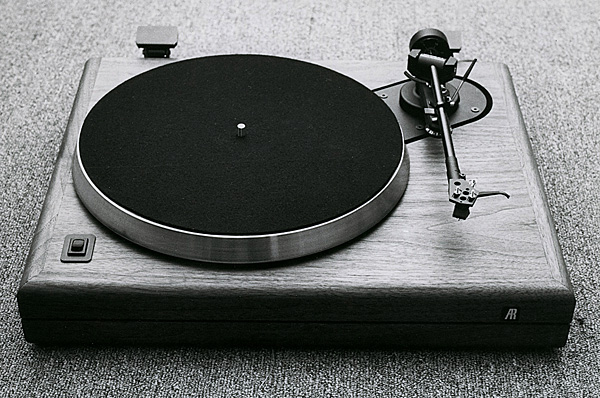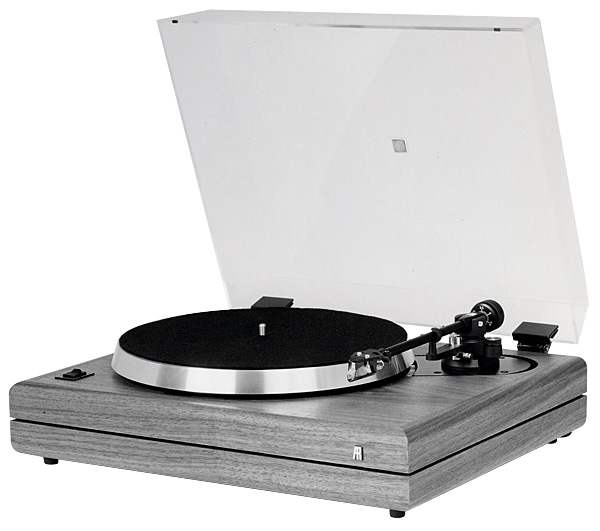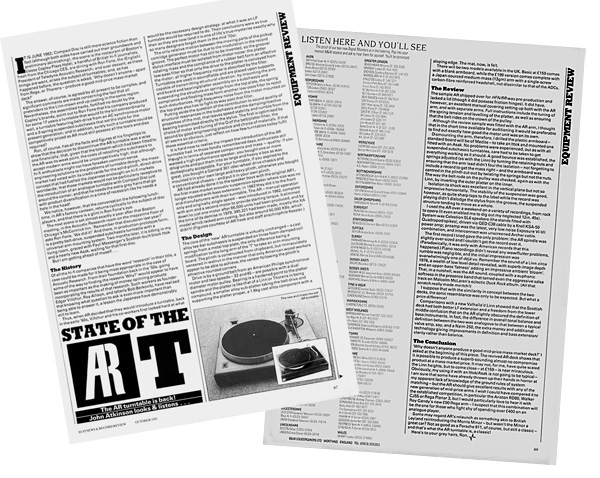State of the AR-T Page 2
The Design
The core of the 'new' AR turntable is virtually unchanged – a cast alloy tee-bar subchassis is suspended on three foam-damped coil springs from a metal top plate, the only difference being a modification to the long arm of the 'T' to take an arm-mounting board.
The plinth is constructed from chipboard, but immaculately veneered in walnut in the manner that only American wood-workers appear to be able to achieve, the veneer following the plinth's attractive rounded corners.

Drive is by a ground belt from an American Philips synchronous motor and two speeds – 33 and 45 – are possible with a dual diameter motor pulley. Bearing is a hardened point to the platter spindle and the platter is like that of a Linn or Thorens in being compound, a smaller alloy sub-platter taking the belt drive and supporting the platter proper, a 1.8kg cast alloy component with a sloping edge. The mat, now, is felt.
There will be two models available in the UK. One at £159 with a blank arm board, while the £199 version comes complete with a Japanese-sourced medium-mass (13g) arm with a single-screw carbon-fibre reinforced headshell.
The sample AR shipped over for HFN/RR was pre-production and lacked a lid (though it did possess friction hinges). lt did have, however, an excellent user manual covering setting-up both with the AR arm, and with separate arms. Full instructions include the tuning of the spring tension and levelling of the platter, as well as ensuring that the belt rides on the crown of the pulley.
Although the review sample was fitted with the AR arm, I thought that in the short time available for auditioning it would be preferable to find out exactly how good the motor unit was on its own. Dismounting the arm, therefore, I drilled the plastic armboard – the standard board will be of Medite – to take an Ittok and mounted one fitted with an Asak. No problems were experienced, but as with all suspended subchassis turntables, care had to be taken to get everything working as it should.

A good bounce was established, the springs adjusted (as with the Linn) by turning the retaining nuts and ensuring that the arm lead didn't foul the isolation – not forgetting to include a record to get the mass right – and the armboard was centred in the plinth cut-out by twisting the springs but not the nuts. The way the belt rode on the pulley was checked, again as with the Linn, by inverting the outer platter on the inner.
Isolation to shock was excellent in the vertical plane but not so impressive horizontally. The stability of the suspension was good, however, as quite sharp taps to the label while the record was playing didn't dislodge the stylus from the groove, the suspended structure tending to move as a whole.
The Review
I used the AR over a weekend while playing a variety of recordings, from rock to opera (the deck even enabled me to dig out my neglected 12in 45s). The system comprised a pair of Celestion SL6 loudspeakers (the stands fitted with Quadropod spikes), driven via QED C38 cable by a Krell KSA-50 power amp. As for the preamp, this was the latest, very low noise Exposure VII with the VI power supply while the interconnect was unscreened Archer cable.

The first record I tried gave the only problem: the AR spindle was slightly over-sized and I couldn't get the record over it. (Paradoxically, it was only with American records that this happened.) Piano recordings didn't reveal any wow/flutter problems, the rumble was negligible, and the initial impression was overwhelmingly one of déjà vu. Remember the sound of a Linn circa 1976, a wealth of low-level detail revealed, with superb image depth and an upper-bass 'fatness' adding an impressive ambient 'bloom'? That, in a nutshell, was the AR sound, coupled with a euphonic softness in the presence band that tamed even the aggressive salsa track on Malcolm McLaren's eclectic Duck Rock album. (All that scratch really made me itch!)
I suppose that with the similarity in concept between the Linn and the AR decks, the sonic resemblance was only to be expected. But what a price difference!
Mid-Price Marvel
Comparisons with a new Linn and Valhalla power supply showed that the Scottish deck had both better LF extension and a freedom from the lower middle confusion that on the AR slightly obscured the definition of bass instruments. In fact, the difference in overall tonal balance and definition between the two was analogous to that between a typical valve amp, say, and a Naim 250, the extra money and additional technology giving improvements in definition and bass extension/clarity rather than balance.
'Why doesn't anyone produce a good mid-price mass-market deck?' was my question at the beginning of this piece. The revived AR deck shows that it is possible to produce a superb-sounding almost no compromise product at a mass-market price. lt may not, for me, have quite scaled the Linn heights, but to come close – at £159 – is near miraculous. Obviously, my using it with an lttok/Asak is not going to be typical – I am sure that some have already thrown up their hands in horror at my apparent lack of knowledge of the ground rules of system matching – but the AR should give excellent results with any of the new generation of mid-price arms.
Conclusion
I wish I could have compared the AR to established rivals, in particular the Ariston RD80, Walker CJ55 or Rega Planar 3, but I would particularly love to hear it with Roy Gandy's new £90 Rega arm. I suspect this combination will be the one for those who fight shy of spending over £400 on an analogue player.
Some may regard AR's relaunch as something akin to British Leyland reintroducing the Morris Minor, but wasn't the Minor a great car? Not as good as a Porsche 911, of course, but still a classic – and that's what the AR turntable is, a classic! Here's to your grey hairs, Ron.
























































